| The Royal Hotel is proposed to be demolished, with only the facades remaining on Spensley Street and Berry St. The roof, chimneys, roof lantern, all of it will be replaced by luxury apartments that will be taller than this building – already the tallest in the precinct. The views of the building from the south and the west will be destroyed and the interior will be completely gutted. Yarra’s planning officers want to waive it through! Their delegation report is a real Halloween shocker. The 3068 Group’s extensive and considered objection was completely ignored. Even advice and recommendations by eminent heritage architect Nigel Lewis were ignored – not rebutted, ignored. Yarra planning has not responded to the perfectly legal and valid objections raised. That is a failure of their responsibility. Fortunately Yarra councillors set aside the officers report and refused demolition. But the applicant has already taken their proposal to VCAT, hoping to overturn the council’s decision. The 3068 Group has responded to VCAT. Below is our objection that will form the basis of our submission to VCAT. For more info: See Save our Royal Hotel  |
| Original 1889 Plans. The towers were never built. |
The 3068 Group’s Submission to Panel Amendment C269 – Local Policy Rewrite
 Amendment C269 Yarra Planning Scheme Review REWRITE OF LOCAL POLICIES In 2020, over 400 locals made submissions to Yarra Council on the future of our city in response to proposed planning policy changes presented through Amendment C269. The decision process is now at Planning Panels Victoria. The hearing is scheduled for Tuesday 5 October — Friday 29 October. 10am–4.30pm. The key issues which will be discussed at the hearing, relate to: ■ Heritage and built form ■ Transport / traffic / car parking ■ Environment and landscape values ■ Environmental risk and amenity ■ Housing ■ Economic development ■ Infrastructure For information about the proposed changes, click on these links: Yarra Planning Scheme Amendment What the review is about C269 Planning Panel Follow the latest official directions from the panel Panel Hearing Timetable see when the community and experts are presenting. Yarra Planning Coalition The Yarra Planning Coalition is a coalition of community groups and individuals who have made submissions on Amendment C269. The 3068 Group is a contributor to the coalition and also making a submission to the panel. |
Object to the Tallest Building in Clifton Hill
Object to the tallest building proposed in Clifton Hill.
The number of objections is closely monitored by decision makers.
How to Object
Its easy to lodge an objection with the City of Yarra’s online objection form.
Or send an email to PlanningAdmin@yarracity.vic.gov.au.
An objection must refer to the application PLN19/0845 592 – 622 Smith Street and 2 – 12 Alexandra Parade and 1 – 7 Reeves Street. This is automatically filled out if you follow this objection form link then click on Lodge an Objection
You must include your name and address and the reasons you object.
If you wish, just include the following points. It only takes a minute.
- The proposed building is far too tall for the precinct and will have wide ranging impacts.
- Dominance, overlooking, noise and light intrusion will impact the amenity of many historic properties to the north and east.
- Proposal is privatising public spaces, roads and lanes.
- Traffic from the proposal should be directed to Alexandra Parade and not be allowed to flow into Council Street.
- Affordable Housing should be provided.
- Demolition of heritage buildings should be refused.
What is Proposed?
The Foundry is a proposed 12 storey development in Clifton Hill, on the corner of Smith Street and Alexandra Parade. It will house commercial and retail space, including a large supermarket and fresh food market and casual dining precinct across three levels. The development will comprise three portions, each made up of four, nine and 12 levels respectively and a 3 level car park.
“Fortis Development Group is seeking planning approval for two towers with 23,000 square metres of office space, and 7000 sq.m. of retail.
The subsidiary of Sydney based Pallas Group, in conjunction with another landowner, has amassed control over at least seven buildings giving it a large 6,500 sq.m. block. The five properties on the corner of Smith Street and Alexandra Parade and Reeves Street, include a historic former foundry. Several of the site’s buildings were purchased by the state to make way for the East West Link tunnel, and were subsequently sold.” [AFR, March 2020]

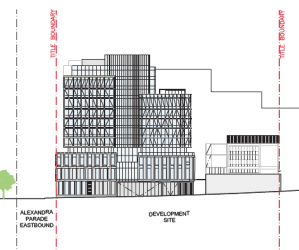
The site is about one sixth the size of the Former Fitzroy Gasworks on the opposite side of Smith Street. In contrast to the Gasworks site, the state government has not placed any height controls on these sites, despite their being much closer to the historic neighbourhood around Council Street. The government has not done any soil contamination assessment, nor has Yarra Council demanded an audit of existing contamination.
Our Objection
The 3068 Group is objecting to this proposal, with detailed objections on Amenity, Traffic, Heritage and Urban Design grounds. We are recommending that members and local residents also submit objections before the proposal is considered by Council’s Internal Development Assessment Committee (IDAC) in the coming cycle.
12 stories plus two stories of plant and equipment (55m) is much too high. Buildings greater than six stories have negative impacts felt far away. The buildings should not be taller or set back less than what is allowed on the Gasworks site, and should follow the Smith Street height controls adopted in Amendment C231 (18m mandatory).
Privatising public lanes should not be supported.
Dominance, overlooking, light pollution and sound intrusion, from proposed east-facing and north-east corner open terraces on levels two through eight will detrimentally impact 148 properties, including those beyond the arbitrary statutory limit of 9 m.
The buildings will be ten times the height and more than ten times the width of the private open space of the single-fronted, single-storey houses which comprise half of the houses to the east of the subject site.
Sustainability
The Application Fails to consider longer term goals of sustainability to build ethical, diverse cities and spaces with spatially aware citizens that would turn the land into a mixed-use suburb, bristling with activity at ground level, rather than the wind-swept settlement of monolithic offices, wide boulevards and hard-edged buildings that are the result of short- term commercial thinking.
Objection is made to the detrimental effects from the height of the proposal on the heritage value of Clifton Hill West Heritage Overlay HO317.
The majority of impacted dwellings are single-storey properties, most are earlier than 1890 and many are earlier than 1870. Modest wooden workers cottages are common.
Objection is made to the detrimental effect on the heritage value of Smith Street.
Facadism is no excuse for heritage destruction.
The proposed tower will disrupt an important landscape view of the internationally recognised heritage shot tower, framed by Napier Reserve (bordered by Alexandra Parade and Queens Parade) and the treed median of historic elms along the length of Alexandra Parade.
Traffic from the site should not be allowed into Council Street.
Vehicle access to Council Street will have an unacceptable impact on the Clifton Hill Western precinct.
A left-in, left-out vehicle access to the site should be provided on Alexandra Parade, with only loading bays on Reeves Street and no truck access to Council Street.
The proponent has not justified the request for a waiver of parking from the statutory 936 places to the proposed 352 places.
The height should not exceed 18 metres (based on C231 Smith Street Precinct 3). It should certainly not exceed the Gasworks mandatory height limit of 10 storeys.
The valued low-rise character of the heritage area should be retained. Non-heritage sites should be redeveloped in scale with surrounding buildings.
The development should fit with its context and the preferred future character.
The street façade on Smith Street should not exceed three storeys or 12 metres with higher development set back a minimum of 8 metres.
Development above street façade height should be setback and the scale should be subservient to contextual buildings along Smith Street.
The development should provide for a range of dwelling types to cater for a variety of housing needs including the provision of up to 10% of dwellings as affordable housing.
An assessment of the level, nature and distribution of any contamination within, or in close proximity to, the land, is required.
Eastern Freeway Heritage Nomination
The 3068 Group’s Draft Submission to Heritage Victoria
Here is a link to the formal submission including footnotes.
Below is the main content. Members may email feedback to the 3068 group committee by COB Friday Feb 7th.
1. The Eastern Freeway Stage One, from Hoddle Street to Bulleen Road, is of social and historic heritage significance to the Wurundjeri people as an invasion of their land and Aboriginal cultural landscape. The whole area of the confluence of the Yarra River and Merri Creek is of particular importance to Aboriginal people, at least two Wurundjeri elders are known to have been interred nearby. “The choice of the confluence as the appropriate burial place of important leaders and warriors highlighted the traditional relevance of the locality’ (Ellender & Christiansen, 2001:116).”
The establishment of the Aboriginal school and Native Police station at the site also indicates the popularity of the confluence as a camping and gathering place for Aboriginal people, and also contributes to the great significance of this place to contemporary Wurundjeri.”

2. The western termination of the Eastern Freeway at Hoddle Street and Alexandra Parade, is of social heritage significance to a community of inner suburbs residents’ associations of the 1970s -90s, to the present day, as the physical artefact of their struggle for greater participation in the centralised planning process. The inner suburbs outside MCC and SCC areas struggled with the impact of redevelopment as they had neither councillors nor staff able to articulate the social and physical impact of high-rise housing and freeways. The residents’ associations were important in their ability to provide the inner suburbs with the capacity to put their arguments and to make their case and to argue it publicly, and to start to develop support and political clout on issues which, in the past, had been just ridden over.
The Eastern Freeway Stage One was developed while Rupert Hamer (1915-2004) was MLA for Kew (1971-1981), Premier of Victoria (1972-1979), and Minister for the Arts for seven years of his nine years premiership. He was a Trustee of Yarra Bend Park in 1982.
Protests from inner Melbourne residents led to the Eastern Freeway being terminated at Hoddle Street in 1977. An essential element in this achievement was their ability to talk the language of the experts and present cases with all the research done, in some cases more effective opponents than those presenting simply a demagogic face.
Following this, inner suburbs residents’ associations’ criticism and opposition to the 2014 East-West Link Project, a proposed 4.4 km tunnel from Hoddle Street, Clifton Hill to CityLink at Parkville led to the project being abandoned by the then opposition leader, Daniel Andrews, in the 2014 state election. In 2019, inner suburbs residents’ associations’ criticism and opposition to the 2018 North East Link Project and Eastern Freeway upgrade was expressed at a Panel. The political climate being generated by this activity was its implications for the wider conduct of political affairs in Victoria.
In 1972, the Eastern Freeway was constructed through the middle of the Park crossing both the Merri Creek and the Yarra River. Parts of the river were relocated and the Deep Rock Swimming Basin was completely demolished. This was highly controversial at the time, heightened by the destruction of rich history of not only of Wurundjeri origin, but European as well. (Wikipedia) The Eastern Freeway bisects the Park, but in the 1980s, attempts to run overhead high voltage power lines from Richmond to Brunswick through the Park failed due to strong community pressure. (Brian Carroll, Encyclopedia of Melbourne online).
Resonance
“… Residents’ associations became more sophisticated, developing sub committees on matters such as planning, education, social welfare, and heritage. The model was the Carlton Association, with its 2000 members, able to divide into numerous sub-committees drawing on the expertise of professional members and academics. There was a more coordinated approach between the associations with the formation of coalitions in Sydney, Melbourne, and Adelaide to achieve greater participation in the planning process, the introduction of third party appeals against development consent and more cooperation with local residents and local government from state planning authorities.”
‘curiously effective’, These words were used by Sydney sociologist, Andrew Jakubowitz in assessing the impact of the urban protest movement and the residents’ associations. Jakubowitz concluded that in Australia, the groups and the issues differed from place to place, and the measure of success varied. But what is important is the political climate being generated by this activity and its implications for the wider conduct of political affairs. An essential element in this achievement was ’their ability to use media and personal contacts within bureaucracies to talk the language of the experts and present cases with “all the research done” in some cases more effective opponents than those presenting simply a demagogic face.

Object to Demolition of 1876 cottage in Queens Parade
193 QUEENS PARADE, CLIFTON HILL
Permit number: PLN19/0539
Please object to this proposal.
If approved, it would set a very dangerous precedent for Queens Parade. If you can take down an original 1870s cottage then what can’t be demolished?

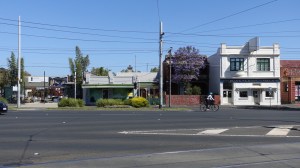

You can find the plans here
The responsible authority won’t make a decision before: Friday 06 December 2019
You can use some of the point from The 3068 Objection to PLN19-0539 – 193 Queens Parade – The 3068 Group Nov 2019
Or use this summary of the main points.
I object to the proposal PLN19/0539 for 193 Queens Parade, Clifton Hill, on the following grounds:
- Demolition of primary heritage fabric, the 1876 cottage ‘Viola’ should be refused.
- Councils independent heritage advice recommends “In regard to the extent of demolition that would be acceptable, it is considered that the front portion of the existing cottage should be retained to the depth of the two front rooms.” This advice has not been followed.
- The cottage is related to the adjacent two storey residence at 191 Queens Parade historically and aesthetically it forms part of a group.
- 1876 chimney should not be demolished or hidden.
- The C231 Panel preferred requirement for minimum street-wall setbacks is to “Retain existing setback”.
- The C231 Panel mandatory minimum upper level setback on Queens Parade is 8m. This is behind the front wall of the 1876 cottage.
- Upper level should be setback behind the chimney.
- New Development should not sit in front of front wall of 191 Queens Parade.
- Rear setbacks do not conform to DDO16 controls recommended by C231 Panel and supported by council.
- New four-storey building is too high for the site context.
- Services on the roof should be hidden.
Amenity
- Traffic in the lane will affect houses in Hodgkinson Street.
- Proposal will overshadow 191 Queens Parade.
Email your objection to PlanningAdmin@yarracity.vic.gov.au
As always, include your name and address and how you will be affected.
William McDougall – Melbourne’s Transport Planning Dysfunction
Respected transport planner William McDougall presents a critical appraisal of Victoria’s recent approach to transport infrastructure investment in Melbourne and Victoria.
Growth will bring enormous transport problems, but policy is in tatters because politics has replaced planning.
New strategic planning approaches desperately needed for Melbourne’s transport future.
Talk Presented to The 3068 AGM.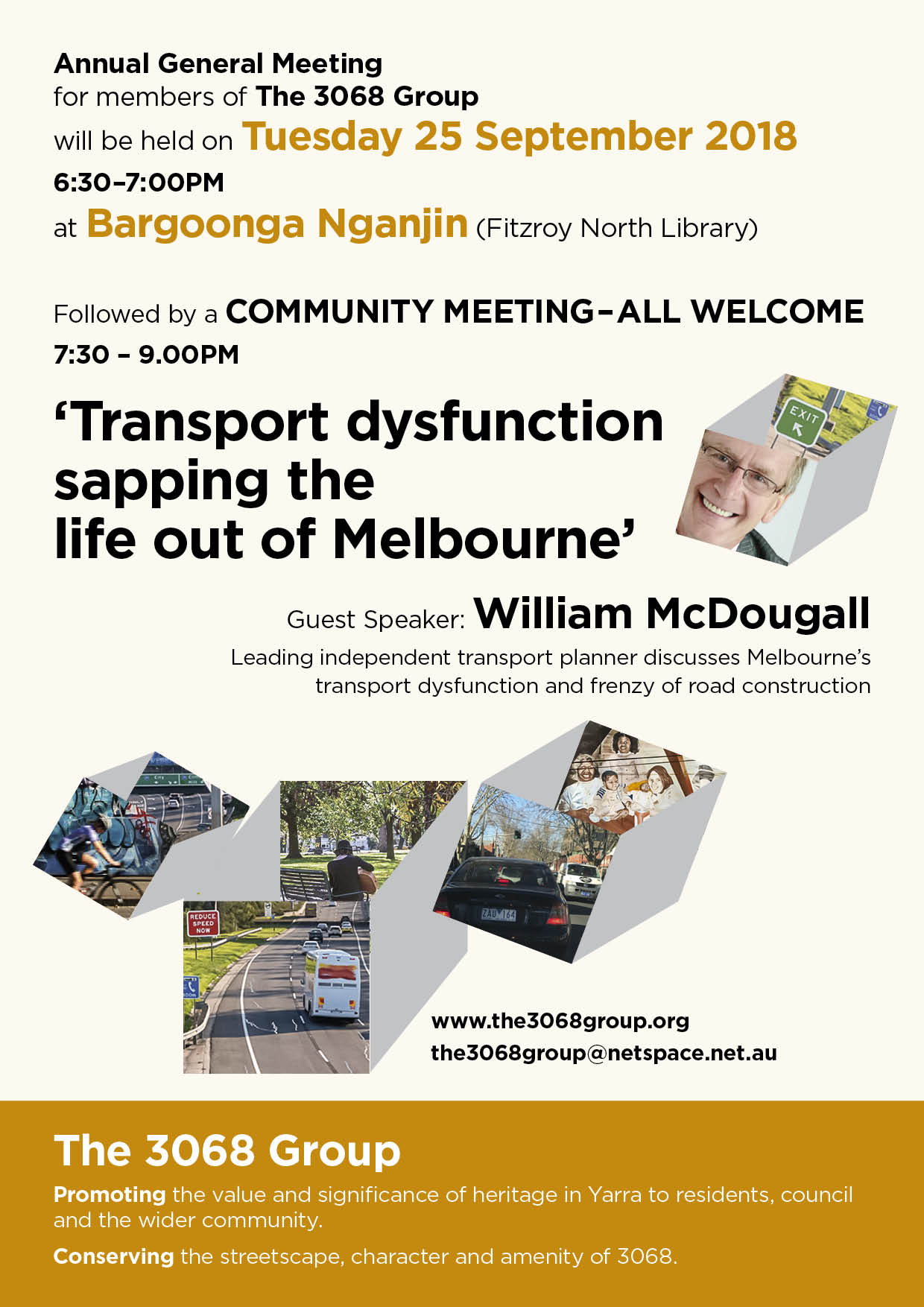
Public Meeting – Melbourne’s Transport Dysfunction
Community Meeting – Melbourne’s transport dysfunction and frenzy of road construction.
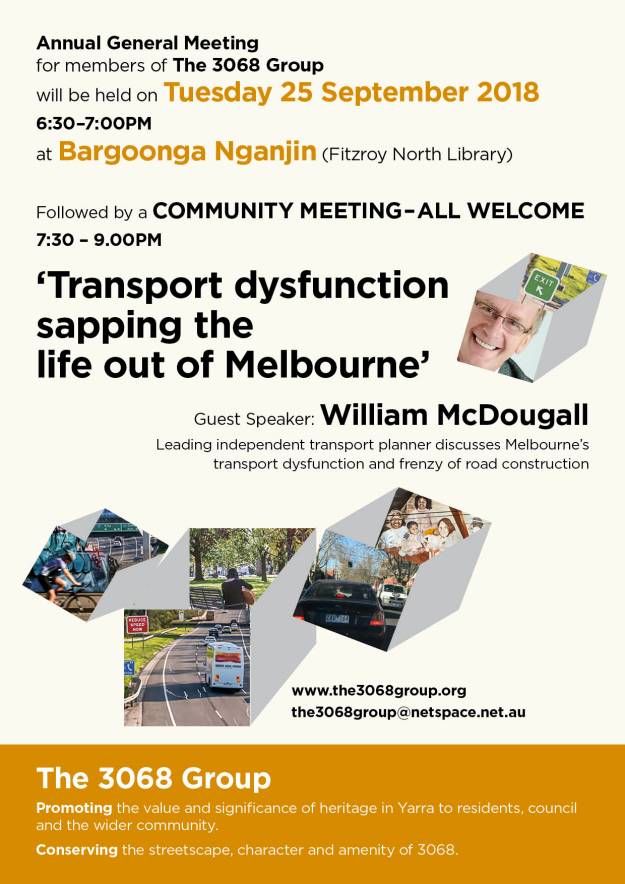
The 3068 Group Committee will host a public meeting from 7:30 – 9.30 pm with guest speaker, William McDougall, discussing Melbourne’s transport dysfunction and frenzy of road construction.
William McDougall is a transport planner with 40 years’ experience. He has advised Labor and Liberal state governments in Victoria on projects including Rod Eddington’s transport plan; the Rowville, Doncaster and airport rail links; the Metro Tunnel; and the West Gate Tunnel. He also led the landmark 1999 Northern Central City Corridor Study that found the East-West Link tunnel was not actually necessary.
Bagung Magali/Waa-Community Room,
Bargoonga Nganjin North Fitzroy Library,
182 St Georges Road, Fitzroy North
Tuesday 25 September 2018 7:30 pm
All Members of The 3068 Group and the public are welcome to attend this event.
Also of interest: Forum on North East Link project
The Whitehorse Council is holding a public forum on Tuesday 11 September to discuss the Victorian government’s proposed North East Link project. The forum is scheduled to commence at 6.30 p.m. and to conclude at 8.30 p.m.
The venue is the Whitehorse Centre which is at the rear of 379 -397 Whitehorse Road, Nunawading (Melway 48 G9). The Centre is seven minutes walk from Nunawading railway station . RSVP at https://whitehorsenelforum.eventbrite.com
Guest speakers will include: Robert Clark MP, Member for Box Hill, Samantha Dunn, MLC, Member for Eastern Metropolitan Region Dr John Stone, Senior Lecturer in Transport Planning, University of Melbourne, Michelle Giovas, Warringal Conservation Society and Friends of Banyule and Chris Trueman, Whitehorse Active Transport Action Group
Farewell to a fine elm
The magnificent elm on Alexandra Parade, west of Wellington St was felled due to a project by Melbourne Water to replace the cover of the Alexandra Parade storm water drain.
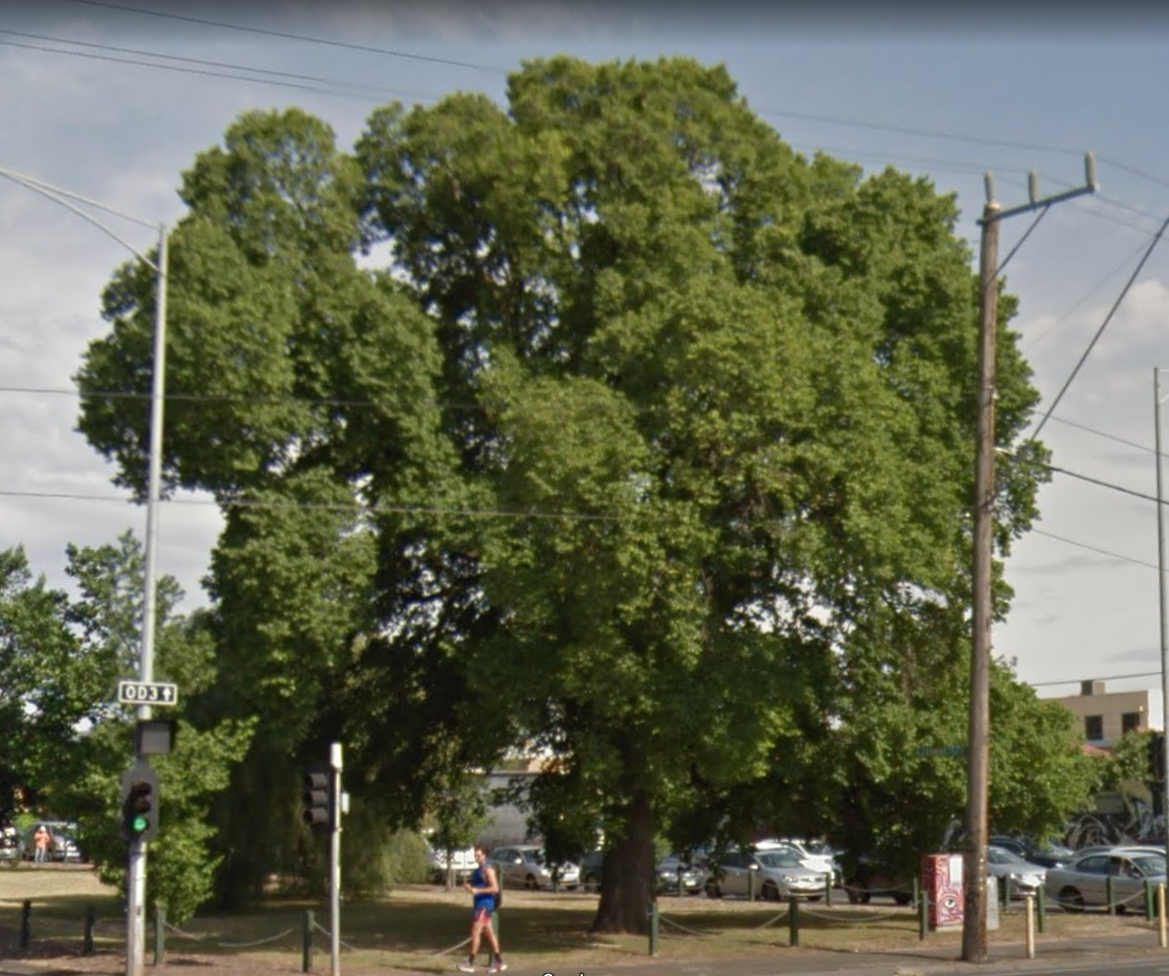
The elm is on Yarra’s Significant Tree Register, but that was not enough to save it. The tree was an outstanding specimen and also made a significant contribution to the landscape due to its prominent position. Large trees also trap deadly particulate pollution from diesel engines. It particles gets trapped in the leaves until they washed down in the rain. Better than getting trapped in your lungs.


In 1977 the Citizens Against Freeways set up a barricade on this reserve at Gold Street. They successfully stopped the Eastern Freeway being extended west of Wellington St towards Carlton.
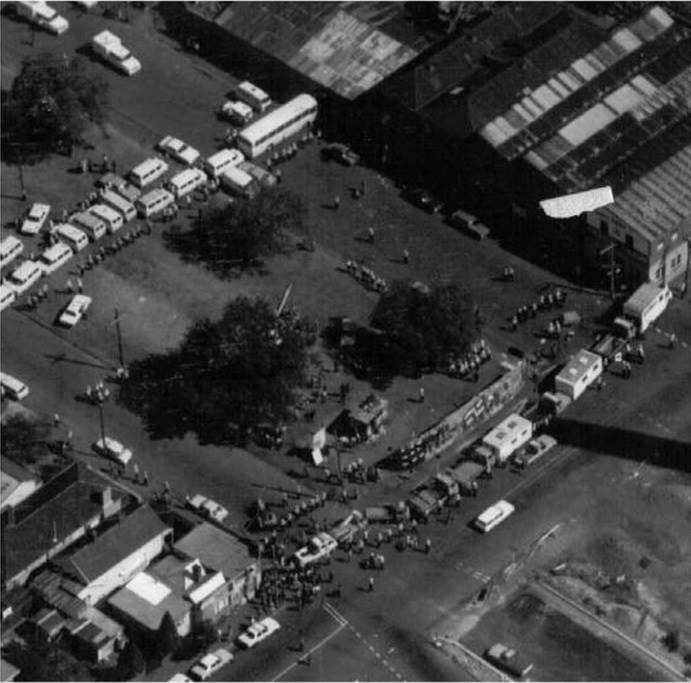
In 2017 Melbourne Water started planning for a project to replace the deck over the main drain under Alexandra Parade, to allow heavy vehicles to drive over it safely.
During the planning stage, the 3068 Group advised Melbourne Water that the elm was of particular significance. Melbourne Water advised in a bulletin that:
Trees along the median listed on the City of Yarra’s Significant Tree Register will be protected, although some pruning may be necessary. The project team has developed a construction methodology to minimize the works footprint and redesigned the deck near significant trees to reduce the number of trees removed. A qualified arborist will be on site and tree protection measures will be in place.
We were saddened to learn that due to a trench being dug one metre from the tree, the project’s arborist has advised that the tree is unstable and should be removed.

trench, subsequently filled, about 1m south of the tree trunk and opposite a root flare.
The 3068 Group requested an inspection by an independent arborist, John Galbraith to see if the tree could be saved.
Unfortunately, Mr. Galbraith’s advice was that the tree would be hard to stabilise and would deteriorate in any case due to the extensive root damage. The tree has also been lopped severely by the project. Mr. Galbraith’s advice was to replace the tree.
The 3068 Group has asked Melbourne Water that a possum guard be attached to the tree before it is felled so that any possums will self-relocate (we don’t know where as there are not that many trees left). We have also asked that a wildlife inspection be performed before and during the felling process to check for nests in the hollows. We also requested that the timber be salvaged for use in park benches. These requests have been accepted.
We also request that a specimen of the same species be planted in the same location, and a row of elms be planted along Alexandra Parade when the project has completed. Melbourne Water has provided a planting plan but won’t plant elms in the Alexandra Parade reserve. They have offered to purchase five elms, but they could end up anywhere in the City of Yarra, and probably not in Collingwood which has the least open space of any suburb in Melbourne.
We are still unclear how so much root damage could be inflicted on a significant tree during an ‘exploratory’ dig. The tree was not placed in a protected zone as is normal practice during building works. The arborist was only called after the damage was done.
Melbourne Water has been relatively transparent about the project and the loss of the tree. Looking at the final works, it would infringe on the drip line and root system of the tree even if best practices were followed. But questions remain, Like why they advised the tree would be safe, and why it did not have a protection zone.
The drain cover and stump of the old tree. June 11, 2018There are a number of significant trees on Alexandra Parade apart from this elm. Melbourne Water has mapped them 170912-Alexandra-Parade-Main-Drain-bulletin-FINAL

Mature oaks on Alexandra Parade, west of Hoddle Street will not be affected by the Streamlining Hoddle Street project
Melbourne Water are also undertaking the M41 Merri Creek to MCG water main renewal. This project replaces a water main through Edinburgh Gardens and George Street Fitzroy. Both are sites of historic elms.

George Street Fitzroy
The maps released so far do not show the works in sufficient detail to assess what trees will be impacted. m41_community_feedback_summary.pdf
We are losing significant trees throughout the city for many reasons. We just learned at a panel hearing that the entire Fitzroy Gas Works 4.6 hectare site is to be denuded of all trees so it can be decontaminated.
Another significant tree, a beautiful Box Elder, was felled in Gold Street opposite the primary school just two months ago, along with many others. If the State government and the developer had been open to changing their plans to incorporate the tree they could have saved it.
Yarra’s planning department gave a permit for a building to be built within the drip line of a significant elm on private land. The planning department says it ignores Yarra’s Significant tree register because it does not form part of the planning scheme! The same department has also resisted any amendment to incorporate the register into the scheme, despite long efforts by some councilors. Getting a tree onto the register takes around a decade. Nominations get lost in the mail.
Last year, Darling Gardens lost the last remaining elm that was on the National Trust Register. The tree was struck by lightning and became unstable. The other registered elm was destroyed by a council path some decades ago.
Near Rushall Station, the management of the Old Colonists Society removed a large number of poplars. This distressed many of their residents. The trees were on private land but overhung the bike path. Close by, Yarra Council plans to remove mature trees on the Merri Creek escarpment for a new bike path.
Most of the world’s cities lost their mature elms to Dutch Elm Disease. Melbourne has a unique and extensive collection dating from the nineteenth century.
They need to be recognised to be protected.

A 160 year old elm tree in the Fitzroy Gardens, The Age, Thursday 3 April 2008.
Further reading in The Conversation: Smart city planning can preserve old trees and the wildlife that needs them.
Sham consultation process 101
One of the uses for the Internet is to publish documents that the government no longer wishes you to see, even though they were paid for by the public. For example, the only place you can access the landmark Northern Central City Corridor Study or the influential Eddington East West Link Needs Assessment is on YCAT.
The following document was originally published along with the Fitzroy Gasworks Amendment documentation, and then republished in an abridged form. it appears to be an internal strategy document.
So to aid researchers and submitter to this amendment, and to see how Stakeholder Analysis is done, here is the original document.
Fitzroy-Gasworks-FEP-2.7-Phase-2-community-engagement-report-Nation-Partners-14-December-2017
The Age reported this as The government report these Victorians were never meant to see (March 20 2018)
Final Curtain for the Star Lyric Theatre
The 3068 Group laments the demolition of the 1911 Star Lyric Theatre. We made submissions to Yarra City Council, objecting to the demolition of the theatre at 239-247 Johnston St, Fitzroy. While other cities protect their heritage and adapt it for new uses, Yarra council in this as in so many cases, was not prepared to fight the developers with their consultants, the State government and VCAT, and its own planning department. No one would stand up for the theatre, so down it comes.
It was one of the most up-to-date theatres for picture shows in the State when opened in 1911. [The Argus, November 6, 1911, p.15]
It was the last of four theatres registered in Fitzroy in 1920:
- Lyric Theatre, Johnston Street
- Solway Theatre, Johnston Street
- Liberty Theatre, 234 Brunswick Street
- Palace Theatre, Nicholson Street,
Although 13 cinemas may have operated in Fitzroy and North Fitzroy over the years, it was also the last of the “Lyric Group”. In 1921, other “Lyric Theatres” were at:
- High Street, Northcote
- 162 Chapel Street, Prahran
- 207 Sydney Road Brunswick
- 114 Stephen Street, Yarraville
- Victoria Street, Prahran
- Esplanade St. Kilda.
Seating capacity was reported to have been 2,300. The theatre was of historic importance for its intact pressed metal ceiling and Warren trusses, with a span of 14.6m, and a height of nearly 14m.
“The arched trusses are innovative in Australian terms, though the use of bolted rather than riveted joints is if anything old-fashioned. They are essentially Pratt trusses in shape intermediate between parallel chorded (or concentric) and crescent shaped. The concentric form was well known in the second half of the nineteenth century, at New York Central Station and elsewhere, and the crescent shape was used by Eiffel for two-hinged arches at Oporto and Garabit, but neither type has been reported in Australia, much less the somewhat ungainly compromise of the Lyric Theatre. In Australia this example is followed by the true crescent shaped Warren truss arches, in timber, of the Manufacturers’ Pavilion, Sydney Showgrounds, c 1937, by Trenchard Smith & Maisy [demolished], then by the steel Warren truss arches of the ‘Igloo’ aircraft hangars of the 1940s”.
– Professor Miles Lewis AM, Faculty of Architecture, University of Melbourne. Correspondence with The 3068 Group, Nov 2013.
“The new Lyric Theatre in Johnston street Fitzroy, was opened in the presence of a crowded house on Saturday night. The building, which has been erected at a cost of £10.000, has a seating capacity of 2.300. The mayor of Fitzroy (Councillor T. M’Mahen), in declaring the the theatre open, said that it was one of the most up-to-date theatres for picture shows in the State. The proprietary were to be congratulated on their enterprise. He congratulated the architects (Messrs. H. B. Gibb and Finlay) and the builders (Messrs. Lockington and Sinclair) on the fine result they had achieved. The pictures shown on Saturday night de-lighted the large house. A particularly good film was a representation of “Faust.”
– The Argus November 6, 1911, p15 http://nla.gov.au/nla.news-article11629737
There is a website by Janine Evans, devoted to the former theatre.
POST SCRIPT

In October 2016, Rone staged an exhibition in the space prior to its complete demolition.
https://www.r-o-n-e.com/empty-project
The photographic record of the exhibition includes a 3D interactive capture of the interior of the former theatre.
